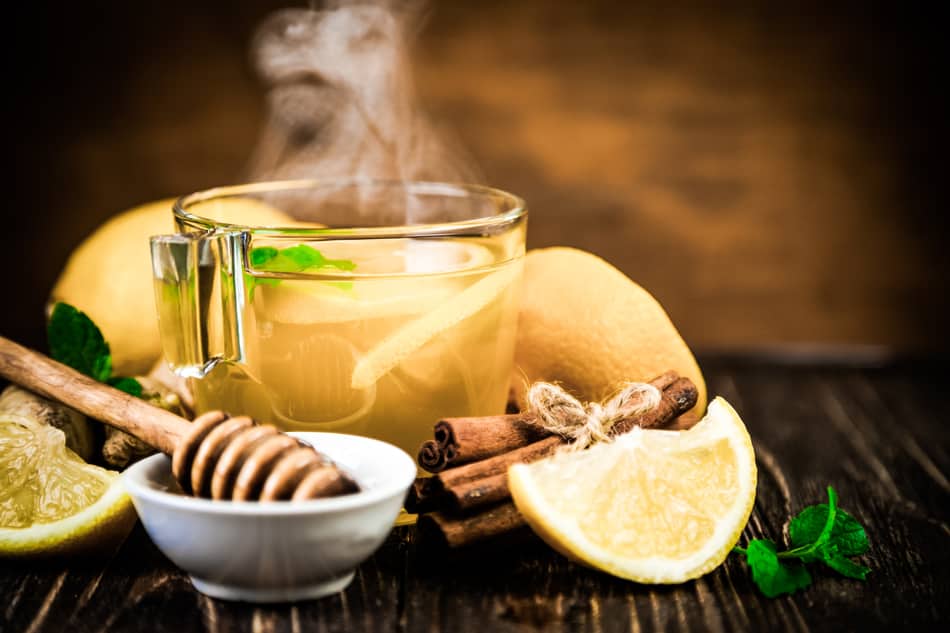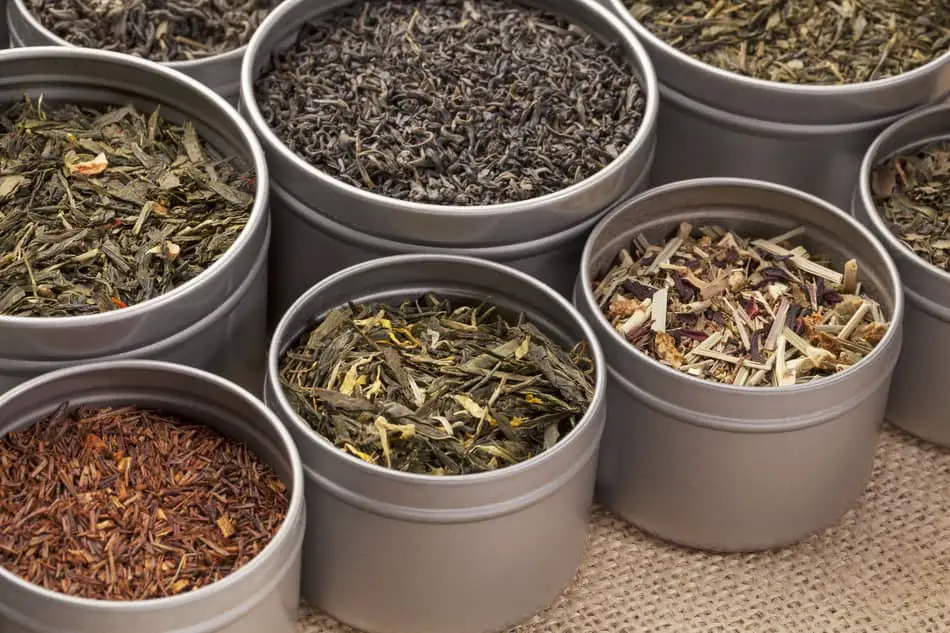
All tea varieties are rich in nutrients, particularly polyphenols, which are plant compounds that can help protect against aging and disease. Which tea variety is healthiest overall? Among black, white, green, oolong, and pu-erh teas, which are all made from the Camellia Sinensis plant, the tea with the greatest range of health benefits is green tea.
Green tea is highest in polyphenols and antioxidant activity among these teas.1 In addition, green tea has more manganese and magnesium than the other teas. Manganese, mangesium and potassium are though to work in concert with the polyphenols in tea to provide their beneficial health efects.1
The tea with the second-highest levels of antioxidants is yellow tea. Yellow tea is not widely available in the U.S., but has been made in China for 1,000 years. During processing it undergoes an additional fermentation step that reduces the tannins that can give green tea a grassy taste. You can find it here on amazon if you’d like to give it a try.
Here is a chart providing a nutritional comparison of these teas. Information on caffeine follows, along with more info on how these teas differ from each other.
Chart is adapted from Klepacka et al1 (see Resources). Note: Standard Deviations have been removed from the data for simplicity’s sake; see the original chart for full details.
| Tea Type | Total Phenolics (mg/mL) | Antioxidant Activity (%) | Copper (µg/mL) | Manganese (µg/mL) | Iron (µg/mL) | Zinc (µg/mL) | Magnesium (µg/mL) | Calcium (µg/mL) | Sodium (µg/mL) | Potassium (µg/mL) |
| White | 61.63 | 34.58 | 5.32 | 482 | 1.99 | 34.9 | 1,133 | 78.7 | 468 | 27,469 |
| Yellow | 79.10 | 40.51 | 4.75 | 289 | 1.96 | 43.4 | 1,752 | 141 | 74.1 | 29,923 |
| Green | 110.73 | 59.02 | 3.62 | 512 | 7.25 | 33.1 | 1,885 | 192 | 63.7 | 29,441 |
| Oolong | 62.66 | 33.70 | 3.66 | 317 | 4.40 | 8.80 | 496 | 433 | 83.9 | 16,752 |
| Pu-erh | 48.63 | 21.12 | 2.74 | 219 | 13.32 | 86.7 | 1,000 | 254 | 259 | 25,382 |
| Black | 69.36 | 33.02 | 4.92 | 286 | 4.36 | 21.9 | 1,660 | 150 | 75.1 | 30,362 |
Compared to black tea, green tea has:
- 60% more phenolics
- 79% more manganese
- 14% more magnesium
Compared to black tea, Pu-erh tea has:
- 3x more iron than black tea
- Almost 4x more zinc than black tea
(Pu-erh is a fermented black tea from China that is known for aging well. It’s not widely available in stores in the U.S., but is becoming more popular. You can try it here on amazon.)
While these relative amounts of minerals are interesting, most teas are not a top source of minerals; their primary value is their polyphenol content (tea is typically low in vitamins as well).
Also, nutrient levels of teas vary widely by where they are grown, as the mineral content of the soil and growing techniques can affect nutrients. However, the chart data gives us a relative comparison. And study after study has shown that green tea has higher levels of phenolics than other types of teas.
By the way, if you’d like to learn more about antioxidants, here is my article on what they are.
Does Length of Brewing Time Tea Affect the Nutrition of Tea?
Time and temperature can affect the antioxidant content of teas, varying by type of tea, according to a 2015 study by the University of Malaya2. The antioxidants in white tea increase with a longer steeping time, but are unaffected by temperature. On the other hand, when black tea steeps longer, antioxidant activity is reduced. In green tea, maximum antioxidant activity occurs when it is steeped for a prolonged time in cold water. Having said all that, any brewing method will bring you benefits, and you should not be concerned if you are not able to follow these brewing guidelines to a “T” (haha!).
How Does Adding Lemon, Honey, Milk or Sugar Affect the Nutrition of Your Tea?

A study was done to answer the question of how adding lemon, honey, milk or sugar affects the antioxidant content of a hot cup of tea3. Adding milk and sugar did not increase antioxidants, unsurprisingly, as milk and sugar are not rich sources of antioxidants. Adding lemon did not heighten the antioxidant content either, even though lemons are a source of antioxidants. It is not understood why. Honey (local flower) did increase antioxidant content. Honey can be a good source of antioxidants but at a tradeoff of calories and carbs.
Caffeine Content of Tea
Aside from their polyphenol and mineral content, another reason to drink tea is for its caffeine.
Many people think the caffeine strength of tea goes in “order” by color, with more caffeine in black, less in green, and the least in white. However, this is not the case.
White tea consists of younger leaves and typically has higher levels of caffeine. However, other studies find that there is tremendous variability in caffeine content not just by tea type, but by brand. One researcher says, referring to both caffeine and theanine content: “it is almost impossible to categorize teas to the groups of white, green, oolong, and black major tea groups.”4 (because of this variability).
| Variety (100 grams) | Caffeine (mg)5* |
| Black Tea | 38 |
| Darjeeling Tea | 39 |
| Earl Grey Tea | 40 |
| Green Tea | 33 |
| White Tea | 41 |
* Where multiple values were listed, I created an average. Based on 3 minute brewing time
Does Brewing Tea Longer Affect Caffeine Content?
Yes, more than type of tea, brewing time will most influence the caffeine content of your tea. The longer you brew, the higher the caffeine level. In the study that provided the data above, the caffeine in Lipton black tea increased 176% when the steeping time went from 1 minute to 5 minutes (not all teas showed such a dramatic increase).
The Nutritional Benefits of Teas
The polyphenols in tea are:
- Flavonols – myricetin, quercetin, kaempferol
- Theaflavins – formed when black tea leaves are oxidized
- Catechins – found in green tea; epigallocatechin-3 gallate (EGCG) is the main form
These compounds have been shown to be antioxidants that have antiallergic, anticancer, antiatherosclerotic and antibacterial and other healthful properties.
The catechins in tea are the most powerful antioxidants among known plant phenols. In some laboratory tests, EGCG is 20 times more active than vitamin C, and 30 times more than vitamin E.6
The theanine in tea has a relaxing effect, which is why the caffeine in tea causes fewer jitters than coffee.
What Are The Differences Between White, Yellow, Green, Oolong, Pu-erh and Black Teas?

All these teas are made from the Camelia sinensis plant. The differences in these teas are how they are processed. As follows:
- White tea undergoes minimal processing and no oxidation. The plants are often shaded before harvest, resulting in a milder-tasting tea.
- Yellow tea is made in a way similar to green tea, but the leaves are steamed for a shorter time at a lower temperature. In addition, the leaves are rarely rolled.
- Green tea is prepared from fresh leaves and buds that are steamed, then rolled and dried. Polyphenol oxidation is inactivated, so the tea remains rich in flavonols such as: catechin, epicatechin, epigallocatechin, flavonoids and simple phenolic acids.
- Oolong tea is made by wilting the fresh leaves in the sun, then bruising them slightly and partially oxidizing them.
- Pu-erh tea undergoes an additional step, as mentioned. After the leaves are dried, they are piled up and stored to age.
- Black tea is made by oxidizing the slightly wilted leaves, which releases enzymes that change the color and flavor of the leaves.
Summing it Up
The key takeaway here is that all these teas offer abundant benefits due to their polyphenols; but green tea has more than other types. By the way, if you are pregnant or nursing, it is best to avoid tea due to its caffeine.
Enjoy!
If you liked this article, you may be interested in what the healthiest variety of nut is; find out here.
What’s the healthiest salad green? Find out here.
What’s the healthiest apple? Get the answer here.
Resources
1 Klepacka, J., Tońska, E., Rafałowski, R., Czarnowska-Kujawska, M., & Opara, B. (2021). Tea as a Source of Biologically Active Compounds in the Human Diet. Molecules (Basel, Switzerland), 26(5), 1487. https://doi.org/10.3390/molecules26051487.
2 Steeping temperature and time may affect antioxidants in tea. ScienceDaily. Retrieved March 5, 2022 from www.sciencedaily.com/releases/2015/12/151216120154.htm.
3 Bartoszek, M., Polak, J. and Chorazewski, M. (2018) Comparison of Antioxidant Capacities of Different Types of Tea Using the Spectroscopy Methods and Semi-Empirical Mathematical Model. European Food Research Technology, 244, 595-601. https://doi.org/10.1007/s00217-017-2986-z.
4 Boros, K., Jedlinszki, N., & Csupor, D. (2016). Theanine and Caffeine Content of Infusions Prepared from Commercial Tea Samples. Pharmacognosy magazine, 12(45), 75–79. https://doi.org/10.4103/0973-1296.176061.
5 Chin, J. M., Merves, M. L., Goldberger, B. A., Sampson-Cone, A., & Cone, E. J. (2008). Caffeine content of brewed teas. Journal of analytical toxicology, 32(8), 702–704. https://doi.org/10.1093/jat/32.8.702.
6 Ferrara, L., Montesano, D., & Senatore, A. (2001). The distribution of minerals and flavonoids in the tea plant (Camellia sinensis). Farmaco (Societa chimica italiana : 1989), 56(5-7), 397–401. https://doi.org/10.1016/s0014-827x(01)01104-1.
